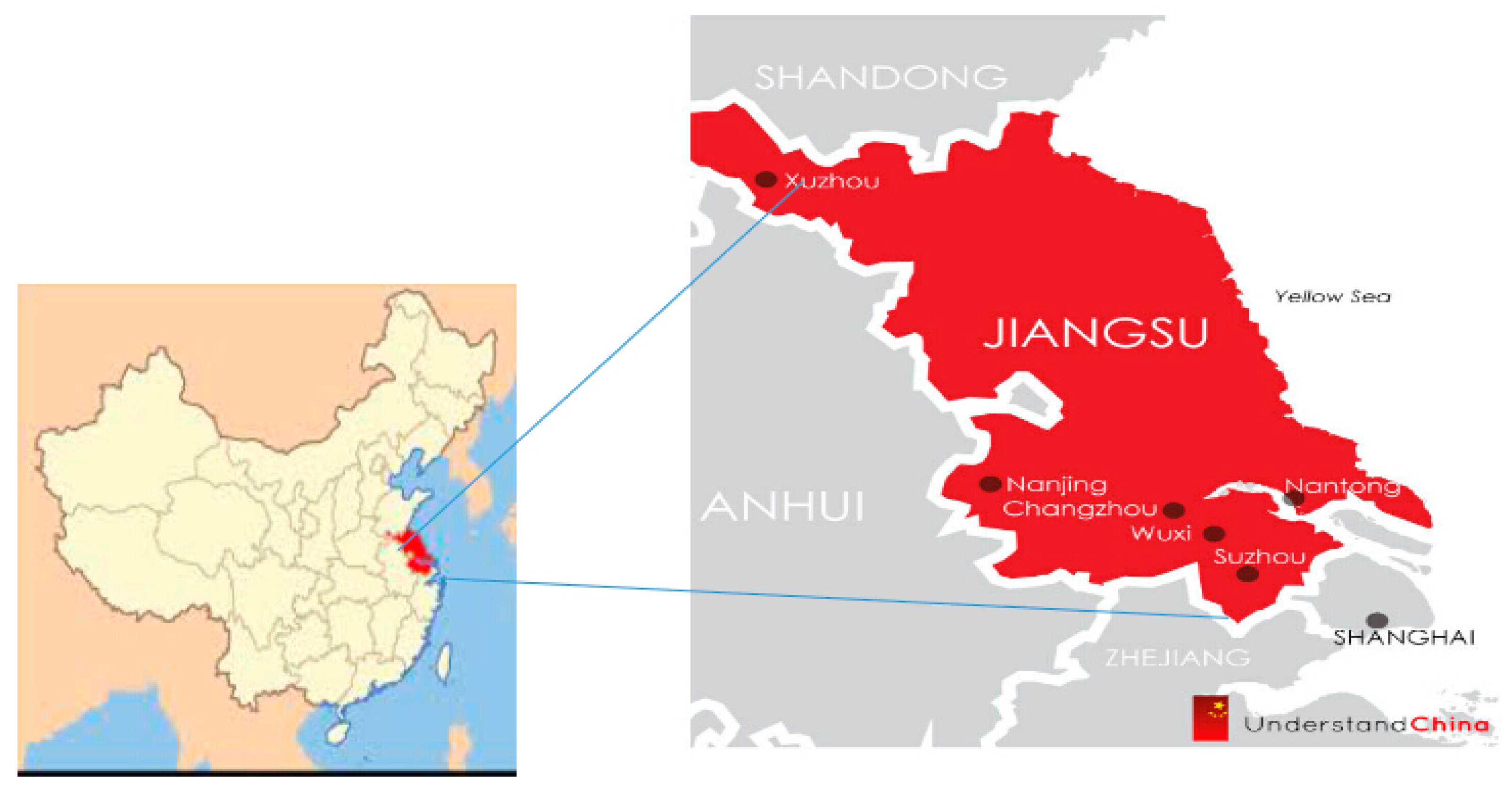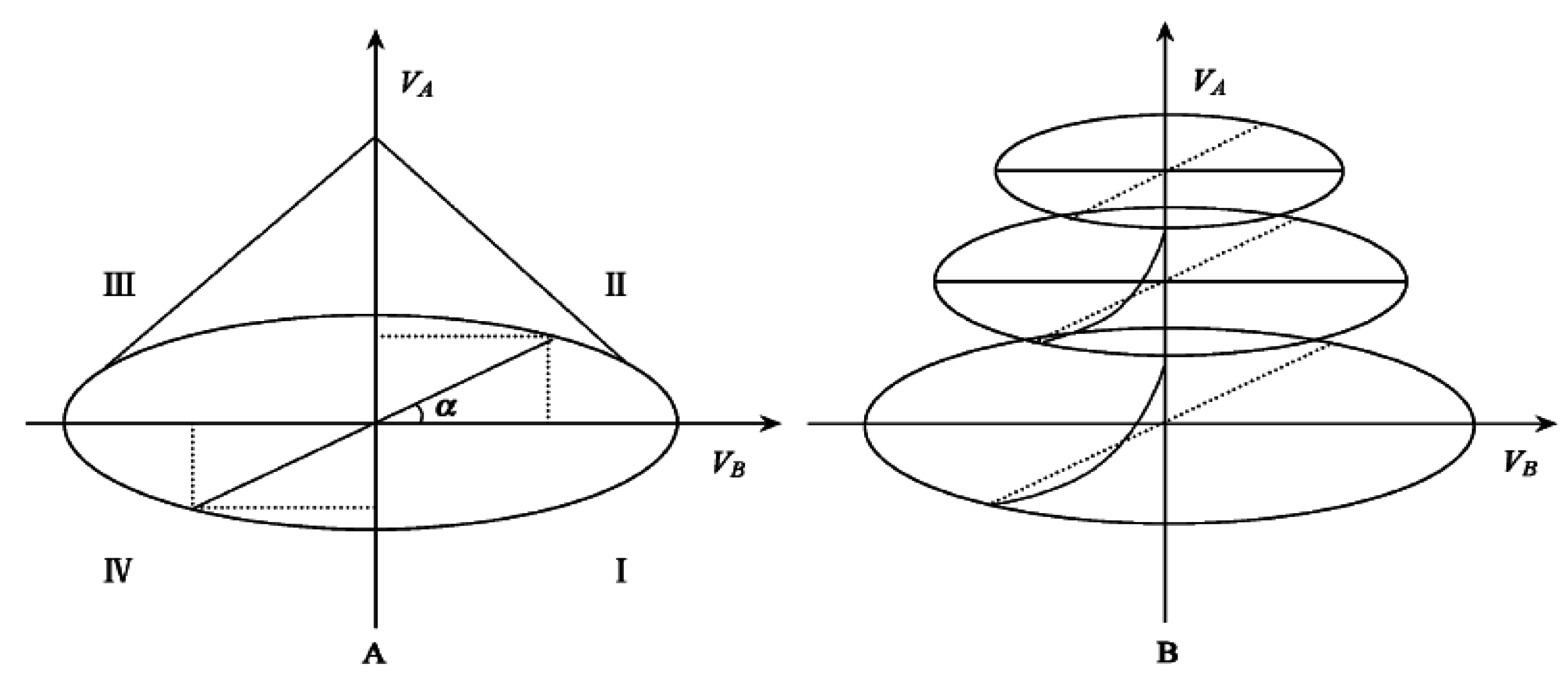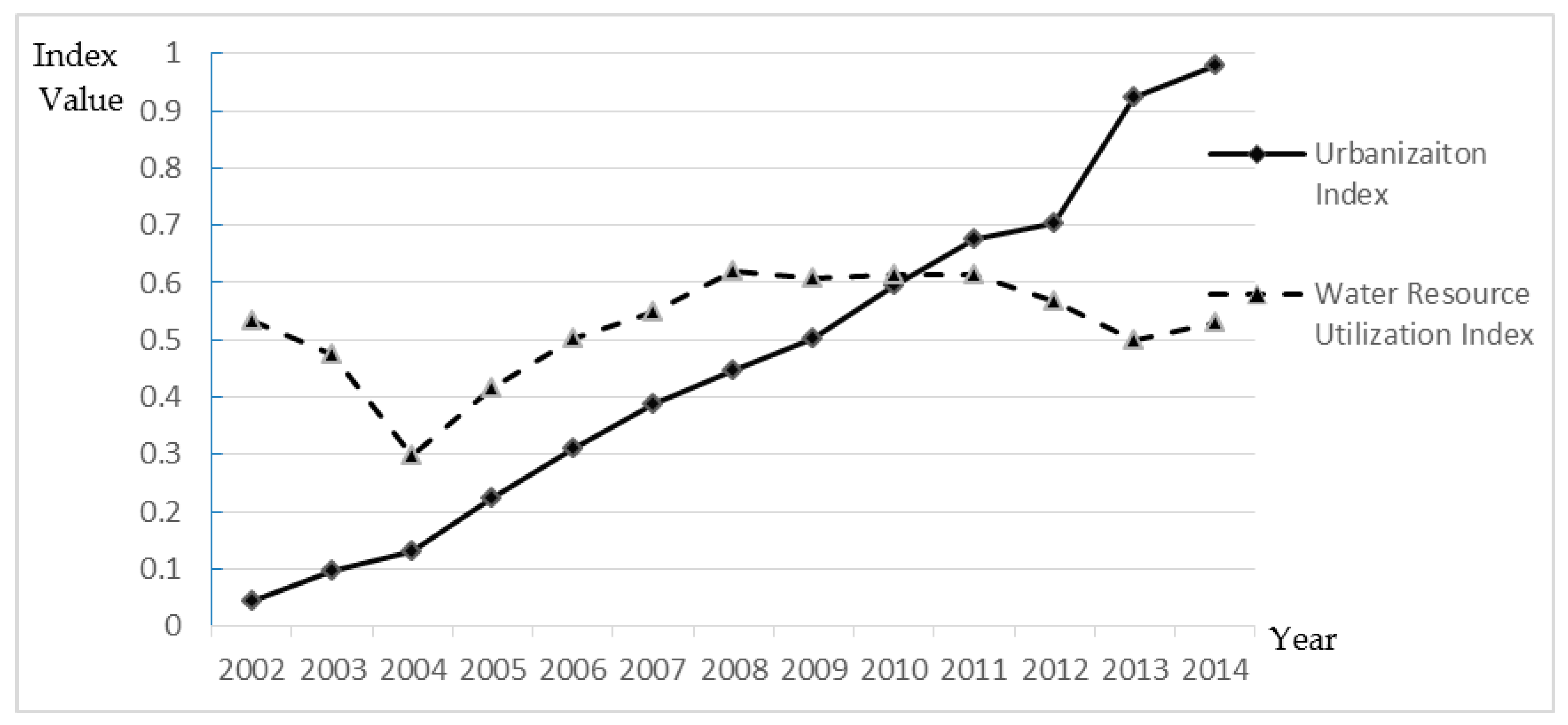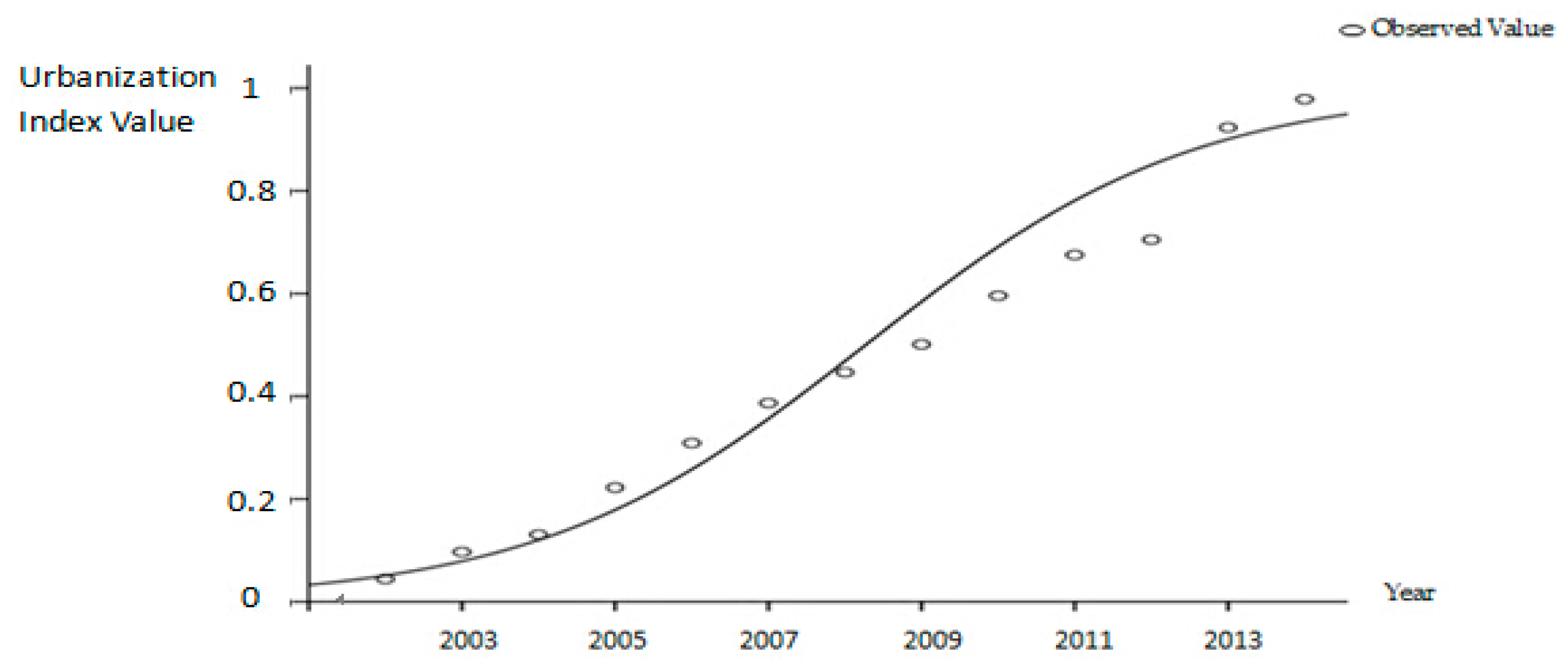Dynamic Coupling Analysis of Urbanization and Water Resource Utilization Systems in China
Abstract
:1. Introduction
2. Material and Methods
2.1. Description of Studied Area
2.2. Methodology
2.2.1. The Coupling Model
2.2.2. Forecasting Model
2.3. Index System for Urbanization and Water Resources Utilization
2.3.1. Construction of the Urbanization Index System
2.3.2. Construction of the Water Resources Utilization Index System
2.3.3. Data Standardization
3. Discussion
3.1. The Index of the Water Resource Utilization System for Jiangsu Province
3.2. The Index of Urbanization in Jiangsu Province
3.3. Coupling Analysis
3.4. Forecasting the Coupling Degree
4. Conclusions
Acknowledgments
Author Contributions
Conflicts of Interest
References
- Davis, J.C.; Henderson, J.V. Evidence on the Political Economy of the Urbanization Process. J. Urban Econ. 2003, 53, 98–125. [Google Scholar] [CrossRef]
- Henderson, V. The Urbanization Process and Economic Growth: The So-What Question. J. Econ. Growth 2003, 8, 47–71. [Google Scholar] [CrossRef]
- McGee, T.G. The Urbanization Process in the Third World; G. Bell and Sons, Ltd.: London, UK, 1971. [Google Scholar]
- Zhang, J. Urbanization, Population Transition, and Growth. Oxf. Econ. Pap. 2002, 54, 91–117. [Google Scholar] [CrossRef]
- Vermeulen, L.C.; De Kraker, J.; Hofstra, N.; Kroeze, C.; Medema, G. Modelling the Impact of Sanitation, Population Growth and Urbanization on Human Emissions of Cryptosporidium to Surface Waters—A Case Study for Bangladesh and India. Environ. Res. Lett. 2015, 10, 094017. [Google Scholar] [CrossRef]
- Loorbach, D.; Shiroyama, H. The Challenge of Sustainable Urban Development and Transforming Cities. In Governance of Urban Sustainability Transitions; Springer: New York, NY, USA, 2016; pp. 3–12. [Google Scholar]
- Feng, L.; Chen, B.; Hayat, T.; Alsaedi, A.; Ahmad, B. The Driving Force of Water Footprint under the Rapid Urbanization Process: A Structural Decomposition Analysis for Zhangye City in China. J. Clean. Prod. 2015. [Google Scholar] [CrossRef]
- Bao, C.; Fang, C.-L. Water Resources Constraint Force on Urbanization in Water Deficient Regions: A Case Study of the Hexi Corridor, Arid Area of Nw China. Ecol. Econ. 2007, 62, 508–517. [Google Scholar] [CrossRef]
- Ma, H.; Shi, C.; Chou, N.-T. China’s Water Utilization Efficiency: An Analysis with Environmental Considerations. Sustainability 2016, 8, 516. [Google Scholar] [CrossRef]
- Xu, C.; Wang, S.; Zhou, Y.; Wang, L.; Liu, W. A Comprehensive Quantitative Evaluation of New Sustainable Urbanization Level in 20 Chinese Urban Agglomerations. Sustainability 2016, 8, 91. [Google Scholar] [CrossRef]
- Ren, W.; Zhong, Y.; Meligrana, J.; Anderson, B.; Watt, W.E.; Chen, J.; Leung, H.-L. Urbanization, Land Use, and Water Quality in Shanghai: 1947–1996. Environ. Int. 2003, 29, 649–659. [Google Scholar] [CrossRef]
- Hubacek, K.; Guan, D.; Barrett, J.; Wiedmann, T. Environmental Implications of Urbanization and Lifestyle Change in China: Ecological and Water Footprints. J. Clean. Prod. 2009, 17, 1241–1248. [Google Scholar] [CrossRef]
- Ding, L.; Chen, K.-L.; Cheng, S.-G.; Wang, X. Water Ecological Carrying Capacity of Urban Lakes in the Context of Rapid Urbanization: A Case Study of East Lake in Wuhan. Phys. Chem. Earth Parts A/B/C 2015, 89, 104–113. [Google Scholar] [CrossRef]
- March, H. Taming, Controlling and Metabolizing Flows: Water and the Urbanization Process of Barcelona and Madrid (1850–2012). Eur. Urban Reg. Stud. 2015, 22, 350–367. [Google Scholar] [CrossRef]
- McDonald, R.I.; Green, P.; Balk, D.; Fekete, B.M.; Revenga, C.; Todd, M.; Montgomery, M. Urban Growth, Climate Change, and Freshwater Availability. Proc. Natl. Acad. Sci. USA 2011, 108, 6312–6317. [Google Scholar] [CrossRef] [PubMed]
- Li, E.; Endter-Wada, J.; Li, S. Characterizing and Contextualizing the Water Challenges of Megacities. JAWRA J. Am. Water Resour. Assoc. 2015, 51, 589–613. [Google Scholar] [CrossRef]
- O’Driscoll, M.; Clinton, S.; Jefferson, A.; Manda, A.; McMillan, S. Urbanization Effects on Watershed Hydrology and in-Stream Processes in the Southern United States. Water 2010, 2, 605–648. [Google Scholar] [CrossRef]
- Zhou, D.; Zhao, S.; Zhang, L.; Sun, G.; Liu, Y. The Footprint of Urban Heat Island Effect in China. Sci. Rep. 2015, 5. [Google Scholar] [CrossRef] [PubMed]
- Elias, E.; Dougherty, M.; Srivastava, P.; Laband, D. The Impact of Forest to Urban Land Conversion on Streamflow, Total Nitrogen, Total Phosphorus, and Total Organic Carbon Inputs to the Converse Reservoir, Southern Alabama, USA. Urban Ecosyst. 2013, 16, 79–107. [Google Scholar] [CrossRef]
- Paul, M.J.; Meyer, J.L. Streams in the Urban Landscape. In Urban Ecology; Springer: New York, NY, USA, 2008; pp. 207–231. [Google Scholar]
- Sun, G.; Lockaby, B.G. Water Quantity and Quality at the Urban–Rural Interface. In Urban–Rural Interfaces: Linking People and Nature; American Society of Agronomy, Soil Science Society of America, Crop Science Society of America, Inc.: Madison, WI, USA, 2012; pp. 29–48. [Google Scholar]
- Zhao, W.; Zhu, X.; Sun, X.; Shu, Y.; Li, Y. Water Quality Changes in Response to Urban Expansion: Spatially Varying Relations and Determinants. Environ. Sci. Pollut. Res. 2015, 22, 16997–17011. [Google Scholar] [CrossRef] [PubMed]
- Shrestha, R.A.; Huang, X.; Sillanpää, M. Effects of Urbanization on Water Quality of the Bagmati River in Kathmandu Valley, Nepal. Stud. Orient. Electron. 2015, 109, 141–150. [Google Scholar]
- Srinivasan, V.; Lambin, E.; Gorelick, S.; Thompson, B.; Rozelle, S. The Nature and Causes of the Global Water Crisis: Syndromes from a Meta-Analysis of Coupled Human-Water Studies. Water Resour. Res. 2012, 48. [Google Scholar] [CrossRef]
- Wu, P.; Tan, M. Challenges for Sustainable Urbanization: A Case Study of Water Shortage and Water Environment Changes in Shandong, China. Procedia Environ. Sci. 2012, 13, 919–927. [Google Scholar] [CrossRef]
- Giacomoni, M.; Kanta, L.; Zechman, E.M. Complex Adaptive Systems Approach to Simulate the Sustainability of Water Resources and Urbanization. J. Water Resour. Plan. Manag. 2013, 139, 554–564. [Google Scholar] [CrossRef]
- Gu, X.; Wang, Y.; Zhao, H.; Wang, F.; Zhu, X.; Lu, G. Linking between Water Resources Utilization and Economic Growth in Jiangsu Province. China Environ. Sci. 2012, 32, 351–358. [Google Scholar]
- Wang, J.; Huang, X.; Zhong, T.; Chen, Z. Climate Change Impacts and Adaptation for Saline Agriculture in North Jiangsu Province, China. Environ. Sci. Policy 2013, 25, 83–93. [Google Scholar] [CrossRef]
- Shuai, J.; Zhang, Z.; Liu, X.; Chen, Y.; Wang, P.; Shi, P. Increasing Concentrations of Aerosols Offset the Benefits of Climate Warming on Rice Yields During 1980–2008 in Jiangsu Province, China. Reg. Environ. Chang. 2013, 13, 287–297. [Google Scholar] [CrossRef]
- Tao, H.; Fischer, T.; Zeng, Y.; Fraedrich, K. Evaluation of Trmm 3b43 Precipitation Data for Drought Monitoring in Jiangsu Province, China. Water 2016, 8, 221. [Google Scholar] [CrossRef]
- Duan, H.; Hu, Q. Local Officials' Concerns of Climate Change Issues in China: A Case from Jiangsu. J. Clean. Prod. 2014, 64, 545–551. [Google Scholar] [CrossRef]
- Fang, C.-L.; Huang, J.-C.; Bu, W.-N. Theoretical Study on Urbanization Process and Ecological Effect with the Restriction of Water Resource in Arid Area of Northwest China. Arid Land Geogr. 2004, 27, 1–7. [Google Scholar]
- Owen, D. Urbanization, Water Quality, and the Regulated Landscape. Univ. Colo. Law Rev. 2011, 82, 431. [Google Scholar] [CrossRef]
- Jašek, R.; Szmit, A.; Szmit, M. Usage of Modern Exponential-Smoothing Models in Network Traffic Modelling. In Nostradamus 2013: Prediction, Modeling and Analysis of Complex Systems; Springer: New York, NY, USA, 2013; pp. 435–444. [Google Scholar]
- Yang, D.; Sharma, V.; Ye, Z.; Lim, L.I.; Zhao, L.; Aryaputera, A.W. Forecasting of Global Horizontal Irradiance by Exponential Smoothing, Using Decompositions. Energy 2015, 81, 111–119. [Google Scholar] [CrossRef]
- Knox, P.L.; McCarthy, L. Urbanization: An Introduction to Urban Geographyr; Pearson Boston: Boston, MA, USA, 2012. [Google Scholar]
- Brenner, N. Theses on Urbanization. Public Cult. 2013, 25, 85–114. [Google Scholar] [CrossRef]
- Buhaug, H.; Urdal, H. An Urbanization Bomb? Population Growth and Social Disorder in Cities. Glob. Environ. Chang. 2013, 23, 1–10. [Google Scholar] [CrossRef]
- Sato, Y.; Zenou, Y. How Urbanization Affect Employment and Social Interactions. Eur. Econ. Rev. 2014, 75, 131–155. [Google Scholar] [CrossRef]
- Hansel, B.; Thomas, F.; Pannier, B.; Bean, K.; Kontush, A.; Chapman, M.J.; Guize, L.; Bruckert, E. Relationship between Alcohol Intake, Health and Social Status and Cardiovascular Risk Factors in the Urban Paris-Ile-De-France Cohort: Is the Cardioprotective Action of Alcohol a Myth? Eur. J. Clin. Nutr. 2010, 64, 561–568. [Google Scholar] [CrossRef] [PubMed]
- Jiangsu Province Statistics Bureau. Statistical Yearbook of Jiangsu Province; Jiangsu Statistics Press: Nanjing, China, 2002. [Google Scholar]
- Jiangsu Province Statistics Bureau. Statistical Yearbook of Jiangsu Province; Jiangsu Statistics Press: Nanjing, China, 2003. [Google Scholar]
- Jiangsu Province Statistics Bureau. Statistical Yearbook of Jiangsu Province; Jiangsu Statistics Press: Nanjing, China, 2004. [Google Scholar]
- Jiangsu Province Statistics Bureau. Statistical Yearbook of Jiangsu Province; Jiangsu Statistics Press: Nanjing, China, 2005. [Google Scholar]
- Jiangsu Province Statistics Bureau. Statistical Yearbook of Jiangsu Province; Jiangsu Statistics Press: Nanjing, China, 2006. [Google Scholar]
- Jiangsu Province Statistics Bureau. Statistical Yearbook of Jiangsu Province; Jiangsu Statistics Press: Nanjing, China, 2007. [Google Scholar]
- Jiangsu Province Statistics Bureau. Statistical Yearbook of Jiangsu Province; Jiangsu Statistics Press: Nanjing, China, 2008. [Google Scholar]
- Jiangsu Province Statistics Bureau. Statistical Yearbook of Jiangsu Province; Jiangsu Statistics Press: Nanjing, China, 2009. [Google Scholar]
- Jiangsu Province Statistics Bureau. Statistical Yearbook of Jiangsu Province; Jiangsu Statistics Press: Nanjing, China, 2010. [Google Scholar]
- Jiangsu Province Statistics Bureau. Statistical Yearbook of Jiangsu Province; Jiangsu Statistics Press: Nanjing, China, 2011. [Google Scholar]
- Jiangsu Province Statistics Bureau. Statistical Yearbook of Jiangsu Province; Jiangsu Statistics Press: Nanjing, China, 2012. [Google Scholar]
- Jiangsu Province Statistics Bureau. Statistical Yearbook of Jiangsu Province; Jiangsu Statistics Press: Nanjing, China, 2013. [Google Scholar]
- Jiangsu Province Statistics Bureau. Statistical Yearbook of Jiangsu Province; Jiangsu Statistics Press: Nanjing, China, 2014. [Google Scholar]
- Zou, Z.H.; Yun, Y.; Sun, J.N. Entropy Method for Determination of Weight of Evaluating Indicators in Fuzzy Synthetic Evaluation for Water Quality Assessment. J. Environ. Sci. 2006, 18, 1020–1023. [Google Scholar] [CrossRef]
- Stauffer, J. The Water Crisis: Constructing Solutions to Freshwater Pollutionr; Routledge: London, UK, 2013. [Google Scholar]
- Srinivasan, V.; Seto, K.C.; Emerson, R.; Gorelick, S.M. The Impact of Urbanization on Water Vulnerability: A Coupled Human–Environment System Approach for Chennai, India. Glob. Environ. Chang. 2013, 23, 229–239. [Google Scholar] [CrossRef]
- Liu, J.; Yang, W. Water Sustainability for China and Beyond. Science 2012, 337, 649–650. [Google Scholar] [CrossRef] [PubMed]
- Jiangsu Water Resources Bureau. Jiangsu Water Resources Bulletin; China Water Conservancy and Hydropower Press: Beijing, China, 2002. [Google Scholar]
- Jiangsu Water Resources Bureau. Jiangsu Water Resources Bulletin; China Water Conservancy and Hydropower Press: Beijing, China, 2003. [Google Scholar]
- Jiangsu Water Resources Bureau. Jiangsu Water Resources Bulletin; China Water Conservancy and Hydropower Press: Beijing, China, 2004. [Google Scholar]
- Jiangsu Water Resources Bureau. Jiangsu Water Resources Bulletin; China Water Conservancy and Hydropower Press: Beijing, China, 2005. [Google Scholar]
- Jiangsu Water Resources Bureau. Jiangsu Water Resources Bulletin; China Water Conservancy and Hydropower Press: Beijing, China, 2006. [Google Scholar]
- Jiangsu Water Resources Bureau. Jiangsu Water Resources Bulletin; China Water Conservancy and Hydropower Press: Beijing, China, 2007. [Google Scholar]
- Jiangsu Water Resources Bureau. Jiangsu Water Resources Bulletin; China Water Conservancy and Hydropower Press: Beijing, China, 2008. [Google Scholar]
- Jiangsu Water Resources Bureau. Jiangsu Water Resources Bulletin; China Water Conservancy and Hydropower Press: Beijing, China, 2009. [Google Scholar]
- Jiangsu Water Resources Bureau. Jiangsu Water Resources Bulletin; China Water Conservancy and Hydropower Press: Beijing, China, 2010. [Google Scholar]
- Jiangsu Water Resources Bureau. Jiangsu Water Resources Bulletin; China Water Conservancy and Hydropower Press: Beijing, China, 2011. [Google Scholar]
- Jiangsu Water Resources Bureau. Jiangsu Water Resources Bulletin; China Water Conservancy and Hydropower Press: Beijing, China, 2012. [Google Scholar]
- Jiangsu Water Resources Bureau. Jiangsu Water Resources Bulletin; China Water Conservancy and Hydropower Press: Beijing, China, 2013. [Google Scholar]
- Jiangsu Water Resources Bureau. Jiangsu Water Resources Bulletin; China Water Conservancy and Hydropower Press: Beijing, China, 2014. [Google Scholar]
- Jiangsu Environment Protection Bureau. Jiangsu Environment Protection Bulletin; China Environmental Yearbook Press: Beijing, China, 2002. [Google Scholar]
- Jiangsu Environment Protection Bureau. Jiangsu Environment Protection Bulletin; China Environmental Yearbook Press: Beijing, China, 2003. [Google Scholar]
- Jiangsu Environment Protection Bureau. Jiangsu Environment Protection Bulletin; China Environmental Yearbook Press: Beijing, China, 2004. [Google Scholar]
- Jiangsu Environment Protection Bureau. Jiangsu Environment Protection Bulletin; China Environmental Yearbook Press: Beijing, China, 2005. [Google Scholar]
- Jiangsu Environment Protection Bureau. Jiangsu Environment Protection Bulletin; China Environmental Yearbook Press: Beijing, China, 2006. [Google Scholar]
- Jiangsu Environment Protection Bureau. Jiangsu Environment Protection Bulletin; China Environmental Yearbook Press: Beijing, China, 2007. [Google Scholar]
- Jiangsu Environment Protection Bureau. Jiangsu Environment Protection Bulletin; China Environmental Yearbook Press: Beijing, China, 2008. [Google Scholar]
- Jiangsu Environment Protection Bureau. Jiangsu Environment Protection Bulletin; China Environmental Yearbook Press: Beijing, China, 2009. [Google Scholar]
- Jiangsu Environment Protection Bureau. Jiangsu Environment Protection Bulletin; China Environmental Yearbook Press: Beijing, China, 2010. [Google Scholar]
- Jiangsu Environment Protection Bureau. Jiangsu Environment Protection Bulletin; China Environmental Yearbook Press: Beijing, China, 2011. [Google Scholar]
- Jiangsu Environment Protection Bureau. Jiangsu Environment Protection Bulletin; China Environmental Yearbook Press: Beijing, China, 2012. [Google Scholar]
- Jiangsu Environment Protection Bureau. Jiangsu Environment Protection Bulletin; China Environmental Yearbook Press: Beijing, China, 2013. [Google Scholar]
- Jiangsu Environment Protection Bureau. Jiangsu Environment Protection Bulletin; China Environmental Yearbook Press: Beijing, China, 2014. [Google Scholar]
- Hsieh, S.-C. Analyzing Urbanization Data Using Rural–Urban Interaction Model and Logistic Growth Model. Comput. Environ. Urban Syst. 2014, 45, 89–100. [Google Scholar] [CrossRef]
- Yan-Guang, C. On the Urbanization Curves: Types, Stages, and Research Methods. Sci. Geogr. Sin. 2012, 1, 12–17. [Google Scholar]
- Sheng, Y.U.; Yin-Feng, X.U.; Zheng, F.F. Online Risk-Reward Starting Strategy of Emergency Preplan against Water Bloom Crisis in Taihu Lake. Oper. Res. Manag. Sci. 2011, 20, 117–124. [Google Scholar]
- Yager, R.R. Exponential Smoothing with Credibility Weighted Observations. Inf. Sci. 2013, 252, 96–105. [Google Scholar] [CrossRef]






| System Layer | Sub-System Layer | Index Layer | Weights |
|---|---|---|---|
| Urbanization | Demographic Factors | Urban population/total population | 0.071 |
| Employment in tertiary industries/total employment | 0.039 | ||
| Urban employment/total employment | 0.185 | ||
| Urban population density | 0.071 | ||
| Economic Factors | GDP per capita | 0.071 | |
| Value-added of the tertiary industries/total GDP | 0.082 | ||
| Disposable income per urban resident | 0.069 | ||
| Social Factors | Social benefits expenses | 0.088 | |
| Engel coefficient of urban households | 0.038 | ||
| Employment in health sector (10,000) | 0.093 | ||
| Numbers of college students | 0.037 | ||
| Environmental Factors | Urban green area/housing area | 0.042 | |
| Green area per capita | 0.038 | ||
| Sulfur dioxide emissions (10,000 ton) | 0.040 | ||
| Comprehensive utilization rate of industrial solid waste | 0.037 |
| System Layer | Sub-System Layer | Index Layer | Weights |
|---|---|---|---|
| Water Resources Utilization Index | Volume of Water Resources | Total volume of water resources (100 million m3) | 0.062 |
| Water resources per capita | 0.078 | ||
| Total volume of production water (100 million m3) | 0.124 | ||
| Total volume of residential water (100 million m3) | 0.114 | ||
| Water Utilization Efficiency | Water usage per 10,000 GDP (m3/10,000 yuan) | 0.177 | |
| Water usage per unit of industrial value-added (m3/10,000 yuan) | 0.064 | ||
| Irrigation water usage per acre of agricultural land | 0.038 | ||
| Water Environmental Management | Industrial wastewater emissions (100 million tons) | 0.076 | |
| Urban residential wastewater emission (100 million tons) | 0.099 | ||
| Sewage control investment/total pollution control investment | 0.120 | ||
| Industrial wastewater discharge compliance rate | 0.049 |
| Year | VA | VB | tanα | α | Quadrant |
|---|---|---|---|---|---|
| 2002 | −0.057 | 0.023 | −2.519 | −68.344° | I |
| 2003 | −0.012 | 0.034 | −0.353 | −19.441° | I |
| 2004 | 0.027 | 0.049 | 0.546 | 28.630° | II |
| 2005 | 0.06 | 0.069 | 0.874 | 41.138° | II |
| 2006 | 0.087 | 0.089 | 0.973 | 44.205° | II |
| 2007 | 0.108 | 0.107 | 1.008 | 45.218° | II |
| 2008 | 0.123 | 0.116 | 1.058 | 46.609° | II |
| 2009 | 0.132 | 0.113 | 1.165 | 49.365° | II |
| 2010 | 0.135 | 0.099 | 1.359 | 53.645° | II |
| 2011 | 0.132 | 0.079 | 1.661 | 58.948° | II |
| 2012 | 0.123 | 0.059 | 2.084 | 64.364° | II |
| 2013 | 0.108 | 0.041 | 2.604 | 68.991° | II |
| 2014 | 0.087 | 0.028 | 3.104 | 72.143° | II |
| Year | Actual Value | α | ||
|---|---|---|---|---|
| 0.7 | 0.8 | 0.9 | ||
| 2012 | 64.364° | 64.682° | 65.335° | 65.398° |
| (0.101) | (0.941) | (1.068) | ||
| 2013 | 68.991° | 70.535° | 70.491° | 70.194° |
| (2.383) | (2.249) | (1.447) | ||
| 2014 | 72.143° | 74.085° | 73.609° | 73.158° |
| (3.771) | (2.151) | (1.031) | ||
| Total Squared Errors | (6.255) | (5.341) | (3.546) | |
| Year | 2015 | 2016 | 2017 | 2018 | 2019 | 2020 |
|---|---|---|---|---|---|---|
| Coupling Degree | 74.088° | 74.799° | 74.276° | 72.519° | 69.528° | 65.304° |
© 2016 by the authors; licensee MDPI, Basel, Switzerland. This article is an open access article distributed under the terms and conditions of the Creative Commons Attribution (CC-BY) license (http://creativecommons.org/licenses/by/4.0/).
Share and Cite
Ma, H.; Chou, N.-T.; Wang, L. Dynamic Coupling Analysis of Urbanization and Water Resource Utilization Systems in China. Sustainability 2016, 8, 1176. https://doi.org/10.3390/su8111176
Ma H, Chou N-T, Wang L. Dynamic Coupling Analysis of Urbanization and Water Resource Utilization Systems in China. Sustainability. 2016; 8(11):1176. https://doi.org/10.3390/su8111176
Chicago/Turabian StyleMa, Hailiang, Nan-Ting Chou, and Lei Wang. 2016. "Dynamic Coupling Analysis of Urbanization and Water Resource Utilization Systems in China" Sustainability 8, no. 11: 1176. https://doi.org/10.3390/su8111176






